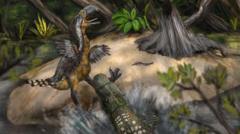Could a Reptile Have Killed the Terror Bird 13 Million Years Ago?

Unearthing the Secrets of the Past: The Battle of the Terror Bird and the Ancient Caiman
The discovery of teeth marks on the leg bone of a terror bird, a large avian reptile that roamed the Earth 13 million years ago, has opened a window into the fierce competition among ancient predators. This fascinating find, made in the Tatacoa Desert of Colombia, provides compelling evidence of a potential violent encounter between two apex predators: the formidable terror bird and the colossal Purussaurus neivensis, an extinct species of caiman. What does this revelation tell us about the ecosystem of the Middle Miocene? Let us delve deeper into this remarkable discovery and its implications for our understanding of prehistoric life.
Understanding the Terror Bird
Terror birds, belonging to the family Phorusrhacidae, were formidable predators that could grow taller than an average human. These flightless birds were characterized by their powerful legs and a beak designed for ripping flesh, making them apex predators of their time. Standing at approximately 2.5 meters tall, they were well-adapted to their environment, utilizing their physical attributes to hunt and defend their territory. Their diet likely consisted of smaller mammals and other birds, placing them at the top of the food chain.
The Discovery of the Fossil
The leg bone, which was first unearthed over 15 years ago by local fossil collector César Augusto Perdomo, has garnered significant attention from paleontologists. The initial discovery took place in the Tatacoa Desert, an area rich in fossilized remains from the Middle Miocene epoch, a time characterized by a warm and humid climate. The unique geographical features of the desert allowed river sediments to preserve the bones of various animals, providing a treasure trove for researchers.
The Analysis of Teeth Marks
Upon closer examination of the fossilized leg bone, scientists noted distinct teeth marks that suggested a violent encounter. The lead researcher, Andres Link from the Universidad de Los Andes, explained that the absence of healing in the bite marks indicates that the terror bird either succumbed to its injuries during the attack or was already dead when the caiman scavenged its remains. This crucial detail adds a layer of complexity to the understanding of predator interactions in ancient ecosystems.
Matching the Marks: A Connection to Purussaurus neivensis
The researchers employed 3D digital scans to analyze the bite marks on the leg bone, comparing their size and shape to the skulls and teeth of various crocodile-like predators preserved in museum collections. The findings pointed towards Purussaurus neivensis, a massive caiman species that could reach lengths of up to five meters. This ancient predator would have employed ambush tactics, lurking near the water’s edge, waiting for unsuspecting prey to approach.
Reconstructing the Battle
Imagining the scene, one can picture the terror bird, a towering figure in the swamp, using its sharp beak and powerful legs to assert dominance over its territory. However, as it approached the water, a lurking caiman lay in wait, ready to strike. The encounter likely escalated into a fierce struggle for survival. This analysis not only reveals the potential vulnerability of the terror bird but also highlights the intricate dynamics of predator-prey relationships in prehistoric ecosystems.
The Ecosystem of the Middle Miocene
The Middle Miocene was a time of significant ecological change. The humid swamps that characterized the Tatacoa Desert were teeming with life, providing a rich habitat for various species, including large mammals, birds, and reptiles. The presence of apex predators like the terror bird and Purussaurus neivensis indicates a complex food web where competition for resources was fierce. Understanding these interactions helps paleontologists reconstruct the ecosystem and gain insight into how it functioned.
Implications of the Discovery
This recent study sheds light on the interactions between two top predators, providing rare evidence of their coexistence and competition. It challenges previous assumptions regarding the terror bird's position in the food chain, suggesting that it was not as invulnerable as once thought. Moreover, the researchers emphasize the importance of each fossilized piece in piecing together the history of life on Earth, showcasing how even a small leg bone can contribute to our understanding of ancient ecosystems.
The Role of Local Fossil Collectors
Local fossil collectors, like César Augusto Perdomo, play a vital role in paleontological research. Their enthusiasm and dedication help unearth significant finds that might otherwise remain hidden. Collaboration between scientists and local collectors can lead to groundbreaking discoveries, as demonstrated by the case of the terror bird's leg bone. This partnership underscores the importance of community involvement in advancing scientific knowledge.
Conclusion: The Legacy of the Terror Bird
The battle between the terror bird and the caiman paints a vivid picture of life in the Middle Miocene. As researchers continue to analyze fossils and piece together the stories they tell, we gain a deeper appreciation for the complexity of ancient ecosystems. The insights gained from this study not only contribute to our understanding of extinct species but also highlight the interconnectedness of life. Each discovery brings us closer to unraveling the mysteries of our planet's past, reminding us of the fierce struggles for survival that have shaped evolution over millions of years.
FAQs
What is a terror bird?
Terror birds, or Phorusrhacidae, were large, flightless predatory birds that lived during the Cenozoic era, particularly in South America. They are known for their impressive height, powerful legs, and sharp beaks.
How did scientists determine the predator responsible for the attack on the terror bird?
Scientists used 3D digital scans to analyze the teeth marks on the fossilized leg bone. By comparing these marks to the skulls and teeth of various crocodile-like predators, they concluded that the marks most closely matched those of Purussaurus neivensis.
What does the absence of healing in the bite marks indicate?
The absence of healing suggests that the terror bird either died during the attack or was already dead when the caiman scavenged its remains. This detail adds context to the potential encounter between the two predators.
What can we learn from fossils about ancient ecosystems?
Fossils provide crucial insights into the interactions between species, the structure of food webs, and the climate conditions of ancient environments. They help researchers reconstruct ecosystems and understand how life on Earth has evolved over millions of years.
As we continue to explore the remnants of our planet's past, what other mysteries do you think await discovery in the depths of ancient fossil beds? #Paleontology #TerrorBirds #AncientEcosystems
```Published: 2025-07-23 03:54:02 | Category: technology



